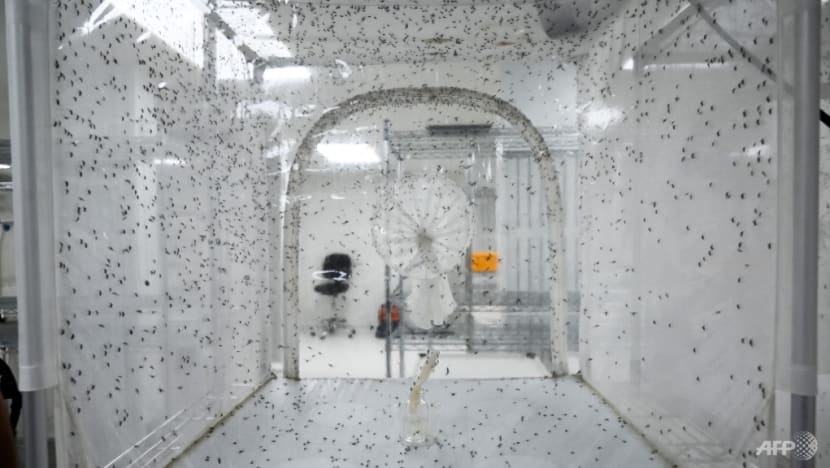Mosquitoes released under Project Wolbachia do not bite, but increased presence can be noticeable: MSE
After male Wolbachia-Aedes mosquitoes are released in new areas, the National Environment Agency receives feedback from residents but they eventually grow accustomed to the programme, said the Ministry of Sustainability and the Environment.

An enclosure filled with mating female and male Wolbachia-carrying mosquitoes at the National Environmental Agency (NEA) mosquitoes production facility in Singapore on Dec 2, 2019. (Photo: AFP/Roslan Rahman)
SINGAPORE: Mosquitoes released under Project Wolbachia by the National Environment Agency (NEA) do not bite, but their increased presence can be noticeable to residents, said Senior Parliamentary Secretary for Sustainability and the Environment Baey Yam Keng on Wednesday (Oct 5).
Mr Baey was addressing feedback received by NEA after Wolbachia-Aedes mosquitoes were released in new areas, but said such feedback is temporary as residents become “accustomed to the programme”.
NEA’s data shows that the population of the wild-type Aedes aegypti mosquito falls to “very low levels” after a few months of releases, decreasing by up to 98 per cent. Bites from these mosquitoes are also significantly reduced, added Mr Baey in Parliament.
“This is evident in the reduction of dengue cases by up to 70 per cent observed in study sites with at least one year of releases,” he said.
“However, as Wolbachia-Aedes technology does not affect other species of mosquitoes, residents may still experience some bites from such mosquitoes.”
How does Project Wolbachia work?
The idea is to release male Aedes aegypti mosquitoes that carry the Wolbachia bacteria so that when they mate with the female Aedes aegypti in an urban environment, the resulting eggs do not hatch due to incompatible matching.
"Regular releases of male Wolbachia-Aedes mosquitoes over time will thus eventually lead to a reduced urban Aedes aegypti mosquito population, and will reduce the potential spread of diseases such as dengue," NEA said in a factsheet in May.
The male mosquitoes do not bite and cannot transmit disease as they feed only on plant juices such as nectar to obtain the sugar they need for energy and survival.
The males will die soon after release, most within a week.
This method is known as the suppression strategy.
COMMUNICATION WITH RESIDENTS AT PROJECT WOLBACHIA SITES
NEA regularly engages residents at Project Wolbachia study sites, said Mr Baey.
Such communication and outreach activities are done prior to releases, and include door-to-door distribution of publicity materials, display of posters and banners at high footfall areas and sharing of information via traditional and social media platforms.
NEA also engages establishments such as childcare centres and schools within the release areas.
In the meantime, “source reduction” remains the key strategy to controlling the population of all types of mosquitoes, added Mr Baey.
Mosquito control measures include a regular practice of the Mozzie Wipeout B-L-O-C-K steps and the “Spray, Apply, Wear” actions to prevent mosquito bites.
B-L-O-C-K stands for Break up hardened soil, Lift and empty flowerpot plates, Overturn pails and wipe their rims, Change water in vases, and Keep roof gutters clear and place BTI insecticide.















